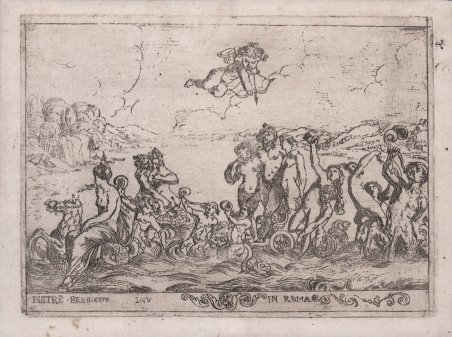Dettagli
Anno di pubblicazione
1617
Incisori
BREBIETTE Pierre
Descrizione
Il trionfo del mare Venere raffigurante la mitologica divinità nata nel mare. La dea è circondata dal suo entourage, suo figlio Cupido vola sopra di lei. Acquaforte, circa 1617/25, firmata in lastra in basso. L’opera è relativa al periodo italiano del Brebiette, 1617-25, come dichiara lo stesso artista nella lastra “In Roma”. Lo stile incisorio vivace e fantasioso di Brebiette è particolarmente efficace in questa stampa di sua invenzione. Le figure mitologiche sono ritratte con uno stile incisorio abile e animato che fa apparire i protagonisti più vicini alla realtà che alla divinità. Il notevole talento di Brebiette per la satira e i dettagli fantasiosi è evidente; l'insieme è impregnato dell'originalità dell'invenzione dell'artista e del suo caratteristico idioma stilistico. Si sa relativamente poco della prima vita e della formazione artistica di Pierre Brebiette. Nel gennaio 1617 viveva a Roma, dove rimase fino al 1625. In Italia Brebiette fu strettamente associato al pittore-incisore Claude Vignon e all'editore di stampe e commerciante di quadri Francois Langlois, detto Ciartres; rimasero amici per tutta la vita. Sebbene sia stato identificato un dipinto, Brebiette fu principalmente un artista grafico, e sono noti un certo numero di bei disegni e quasi 300 stampe. La sua opera incisa include soggetti di genere, mitologici e religiosi. È probabile che Brebiette sia stato introdotto all'incisione a Roma; il suo lavoro riflette lo stile e le tecniche degli incisori italiani di quel luogo: Antonio Tempesta (1555-1630), Orazio Borgianni (circa 1578-1616) e Ottavio Leoni (1578-1630). In Italia alcune delle stampe di Brebiette riproducevano dipinti di maestri rinascimentali come Andrea del Sarto e Paolo Veronese, e di pittori romani più recenti come Cesare d'Arpino. Bellissima prova, impressa su carta vergata coeva, con piccoli margini, in ottimo stato di conservazione. Timbro di collezione al verso di Agostino Caironi (Lugt n. 426). Bibliografia Le Blanc, Manuel de l'amateur d'estampes, contenant un dictionnaire des graveurs de toutes les nations: ouvrage destiné à faire suite au Manuel du libraire par J.Ch. Brunet, dl. 1, p. 513, n. 65; Inventaire du Fonds Français: Bibliothèque Nationale, Département des Estampes (92). The Triumph of the Sea Venus depicting the mythological sea-born divinity. The goddess is surrounded by her entourage, her son Cupid flying above her. Etching, ca. 1617/25, signed in plate at bottom. The work relates to Brebiette's Italian period, 1617-25, as the artist himself states in the plate "In Roma". Brebiette's lively and imaginative engraving style is particularly effective in this print of his own invention. The mythological figures are portrayed with a deft and animated engraving style that makes the protagonists appear closer to reality than to divinity. Brebiette's considerable talent for satire and imaginative detail is evident; the whole is imbued with the originality of the artist's invention and his characteristic stylistic idiom. Relatively little is known about Pierre Brebiette's early life and artistic formation. By January 1617 he was living in Rome, where he remained until 1625. In Italy Brebiette was closely associated with the painter-etcher Claude Vignon and the print publisher and paintings dealer Francois Langlois, called Ciartres; they remained friends for life. Although one painting has been identified, Brebiette was primarily a graphic artist, and a number of fine drawings and nearly 300 prints by him are known. His etched oeuvre includes genre, mythological, and religious subjects. Brebiette was likely to have been introduced to etching in Rome; his work reflects the style and techniques of Italian etchers there: Antonio Tempesta (1555-1630), Orazio Borgianni (about 1578-1616), and Ottavio Leoni (1578-1630). In Italy some of Brebiette's prints reproduced paintings by such Renaissance masters as Andrea del Sarto and Paolo Veronese, and more recent Roman painters including Cesare d'Arpino. Beautiful impression, printed on contemporary laid paper with small margins, in very good condition. Collection mark on verso of Agostino Caironi (Lugt no. 426). Bibliografia Le Blanc, Manuel de l'amateur d'estampes, contenant un dictionnaire des graveurs de toutes les nations: ouvrage destiné à faire suite au Manuel du libraire par J.Ch. Brunet, dl. 1, p. 513, n. 65; Inventaire du Fonds Français: Bibliothèque Nationale, Département des Estampes (92). Cfr.

Scopri come utilizzare
Scopri come utilizzare

